Management Accounting
VerifiedAdded on 2022/11/25
|11
|2535
|58
AI Summary
This assessment analyzes the costing process and activities carried out by Connectta Ltd. It focuses on job costing system, allocation of overhead costs, treatment of under/over applied overheads, and the application of activity-based costing system.
Contribute Materials
Your contribution can guide someone’s learning journey. Share your
documents today.
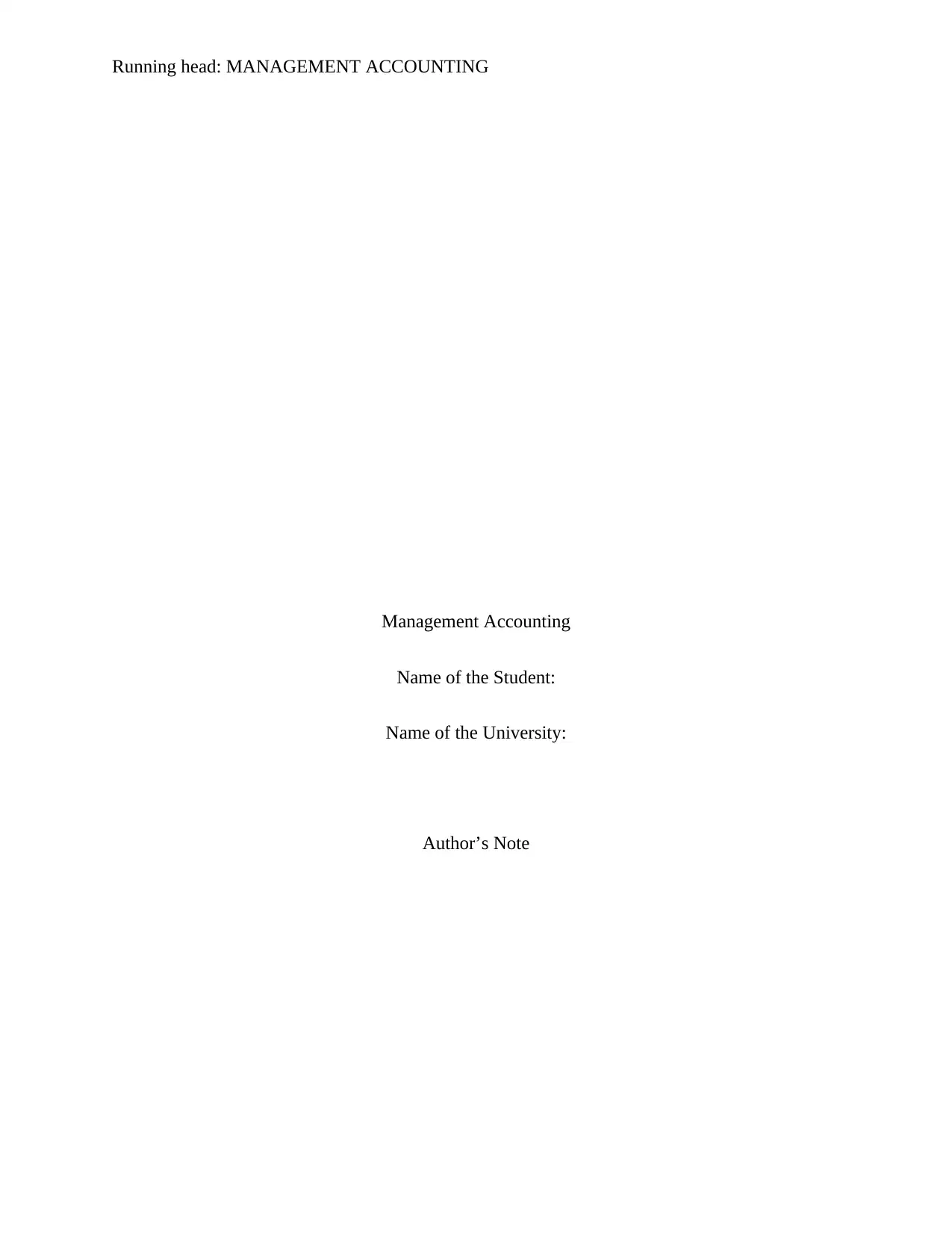
Running head: MANAGEMENT ACCOUNTING
Management Accounting
Name of the Student:
Name of the University:
Author’s Note
Management Accounting
Name of the Student:
Name of the University:
Author’s Note
Secure Best Marks with AI Grader
Need help grading? Try our AI Grader for instant feedback on your assignments.
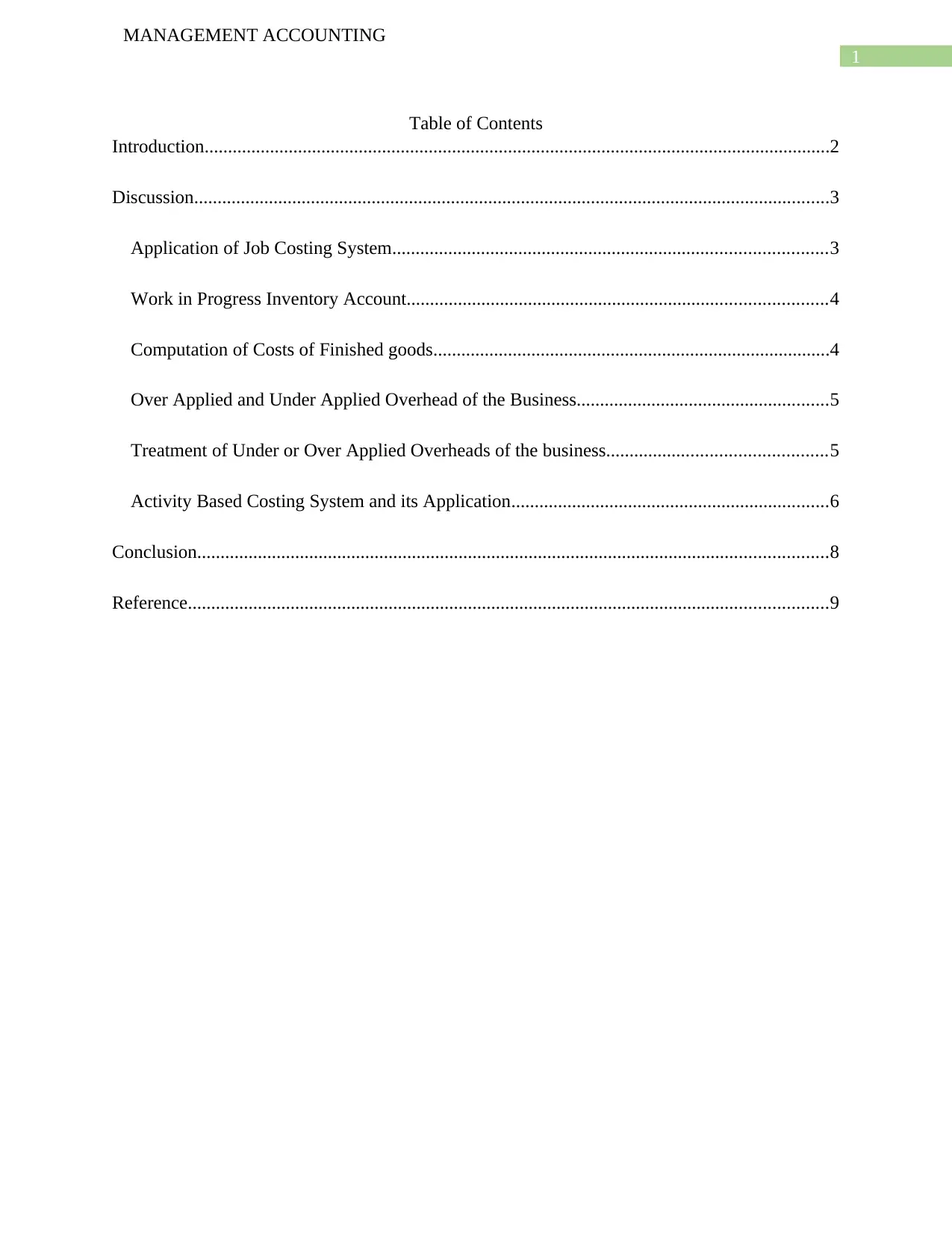
1
MANAGEMENT ACCOUNTING
Table of Contents
Introduction......................................................................................................................................2
Discussion........................................................................................................................................3
Application of Job Costing System.............................................................................................3
Work in Progress Inventory Account..........................................................................................4
Computation of Costs of Finished goods.....................................................................................4
Over Applied and Under Applied Overhead of the Business......................................................5
Treatment of Under or Over Applied Overheads of the business...............................................5
Activity Based Costing System and its Application....................................................................6
Conclusion.......................................................................................................................................8
Reference.........................................................................................................................................9
MANAGEMENT ACCOUNTING
Table of Contents
Introduction......................................................................................................................................2
Discussion........................................................................................................................................3
Application of Job Costing System.............................................................................................3
Work in Progress Inventory Account..........................................................................................4
Computation of Costs of Finished goods.....................................................................................4
Over Applied and Under Applied Overhead of the Business......................................................5
Treatment of Under or Over Applied Overheads of the business...............................................5
Activity Based Costing System and its Application....................................................................6
Conclusion.......................................................................................................................................8
Reference.........................................................................................................................................9
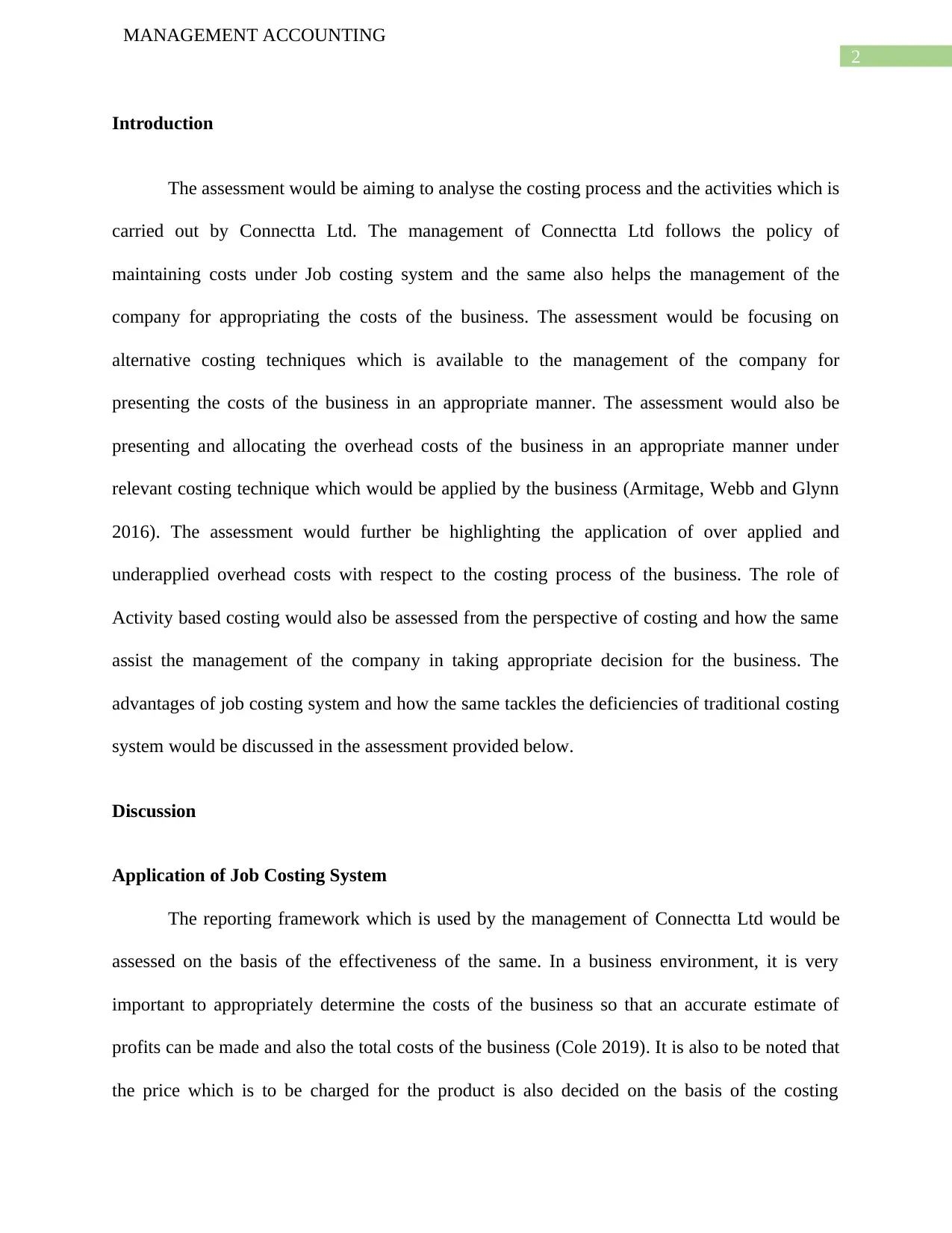
2
MANAGEMENT ACCOUNTING
Introduction
The assessment would be aiming to analyse the costing process and the activities which is
carried out by Connectta Ltd. The management of Connectta Ltd follows the policy of
maintaining costs under Job costing system and the same also helps the management of the
company for appropriating the costs of the business. The assessment would be focusing on
alternative costing techniques which is available to the management of the company for
presenting the costs of the business in an appropriate manner. The assessment would also be
presenting and allocating the overhead costs of the business in an appropriate manner under
relevant costing technique which would be applied by the business (Armitage, Webb and Glynn
2016). The assessment would further be highlighting the application of over applied and
underapplied overhead costs with respect to the costing process of the business. The role of
Activity based costing would also be assessed from the perspective of costing and how the same
assist the management of the company in taking appropriate decision for the business. The
advantages of job costing system and how the same tackles the deficiencies of traditional costing
system would be discussed in the assessment provided below.
Discussion
Application of Job Costing System
The reporting framework which is used by the management of Connectta Ltd would be
assessed on the basis of the effectiveness of the same. In a business environment, it is very
important to appropriately determine the costs of the business so that an accurate estimate of
profits can be made and also the total costs of the business (Cole 2019). It is also to be noted that
the price which is to be charged for the product is also decided on the basis of the costing
MANAGEMENT ACCOUNTING
Introduction
The assessment would be aiming to analyse the costing process and the activities which is
carried out by Connectta Ltd. The management of Connectta Ltd follows the policy of
maintaining costs under Job costing system and the same also helps the management of the
company for appropriating the costs of the business. The assessment would be focusing on
alternative costing techniques which is available to the management of the company for
presenting the costs of the business in an appropriate manner. The assessment would also be
presenting and allocating the overhead costs of the business in an appropriate manner under
relevant costing technique which would be applied by the business (Armitage, Webb and Glynn
2016). The assessment would further be highlighting the application of over applied and
underapplied overhead costs with respect to the costing process of the business. The role of
Activity based costing would also be assessed from the perspective of costing and how the same
assist the management of the company in taking appropriate decision for the business. The
advantages of job costing system and how the same tackles the deficiencies of traditional costing
system would be discussed in the assessment provided below.
Discussion
Application of Job Costing System
The reporting framework which is used by the management of Connectta Ltd would be
assessed on the basis of the effectiveness of the same. In a business environment, it is very
important to appropriately determine the costs of the business so that an accurate estimate of
profits can be made and also the total costs of the business (Cole 2019). It is also to be noted that
the price which is to be charged for the product is also decided on the basis of the costing
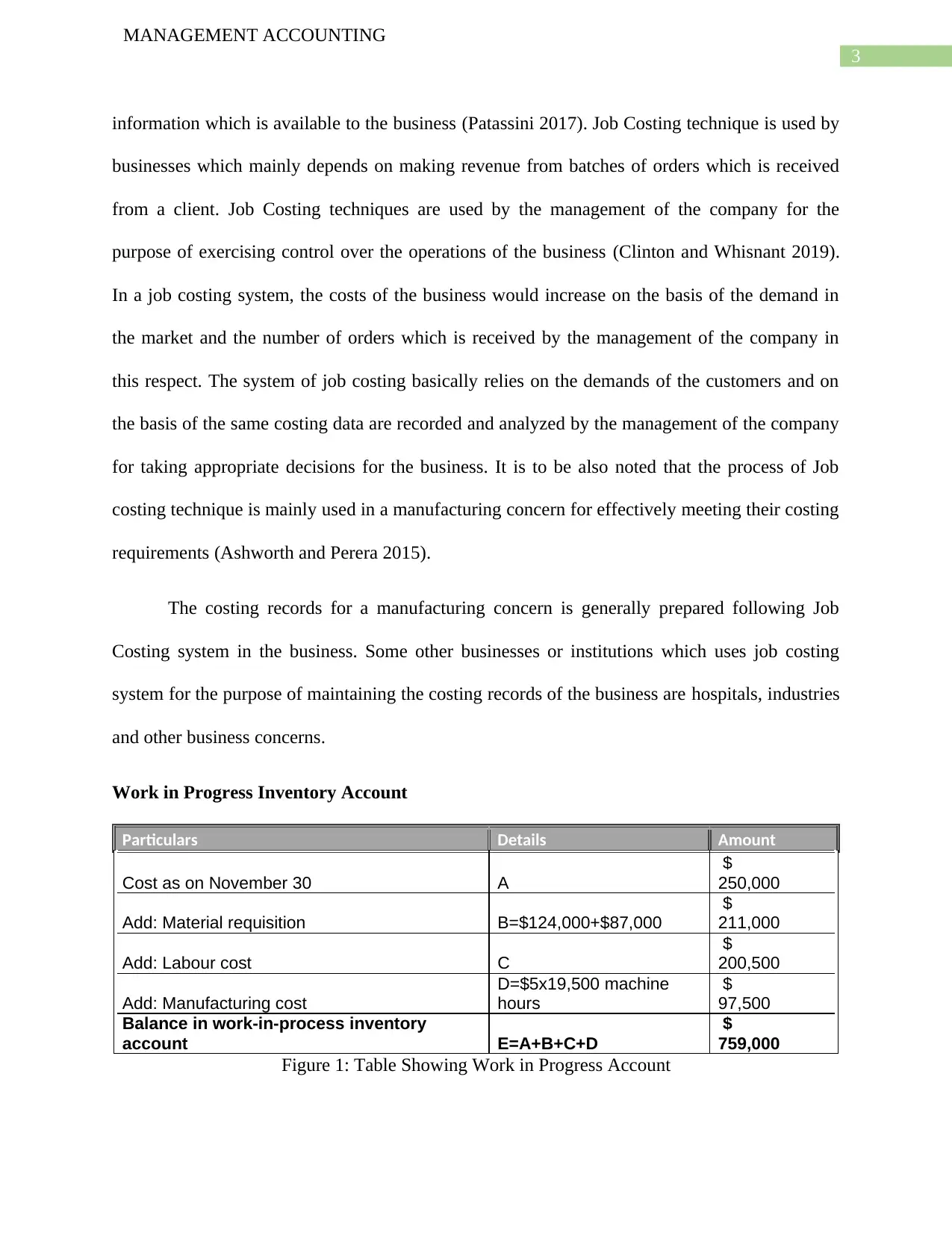
3
MANAGEMENT ACCOUNTING
information which is available to the business (Patassini 2017). Job Costing technique is used by
businesses which mainly depends on making revenue from batches of orders which is received
from a client. Job Costing techniques are used by the management of the company for the
purpose of exercising control over the operations of the business (Clinton and Whisnant 2019).
In a job costing system, the costs of the business would increase on the basis of the demand in
the market and the number of orders which is received by the management of the company in
this respect. The system of job costing basically relies on the demands of the customers and on
the basis of the same costing data are recorded and analyzed by the management of the company
for taking appropriate decisions for the business. It is to be also noted that the process of Job
costing technique is mainly used in a manufacturing concern for effectively meeting their costing
requirements (Ashworth and Perera 2015).
The costing records for a manufacturing concern is generally prepared following Job
Costing system in the business. Some other businesses or institutions which uses job costing
system for the purpose of maintaining the costing records of the business are hospitals, industries
and other business concerns.
Work in Progress Inventory Account
Particulars Details Amount
Cost as on November 30 A
$
250,000
Add: Material requisition B=$124,000+$87,000
$
211,000
Add: Labour cost C
$
200,500
Add: Manufacturing cost
D=$5x19,500 machine
hours
$
97,500
Balance in work-in-process inventory
account E=A+B+C+D
$
759,000
Figure 1: Table Showing Work in Progress Account
MANAGEMENT ACCOUNTING
information which is available to the business (Patassini 2017). Job Costing technique is used by
businesses which mainly depends on making revenue from batches of orders which is received
from a client. Job Costing techniques are used by the management of the company for the
purpose of exercising control over the operations of the business (Clinton and Whisnant 2019).
In a job costing system, the costs of the business would increase on the basis of the demand in
the market and the number of orders which is received by the management of the company in
this respect. The system of job costing basically relies on the demands of the customers and on
the basis of the same costing data are recorded and analyzed by the management of the company
for taking appropriate decisions for the business. It is to be also noted that the process of Job
costing technique is mainly used in a manufacturing concern for effectively meeting their costing
requirements (Ashworth and Perera 2015).
The costing records for a manufacturing concern is generally prepared following Job
Costing system in the business. Some other businesses or institutions which uses job costing
system for the purpose of maintaining the costing records of the business are hospitals, industries
and other business concerns.
Work in Progress Inventory Account
Particulars Details Amount
Cost as on November 30 A
$
250,000
Add: Material requisition B=$124,000+$87,000
$
211,000
Add: Labour cost C
$
200,500
Add: Manufacturing cost
D=$5x19,500 machine
hours
$
97,500
Balance in work-in-process inventory
account E=A+B+C+D
$
759,000
Figure 1: Table Showing Work in Progress Account
Secure Best Marks with AI Grader
Need help grading? Try our AI Grader for instant feedback on your assignments.
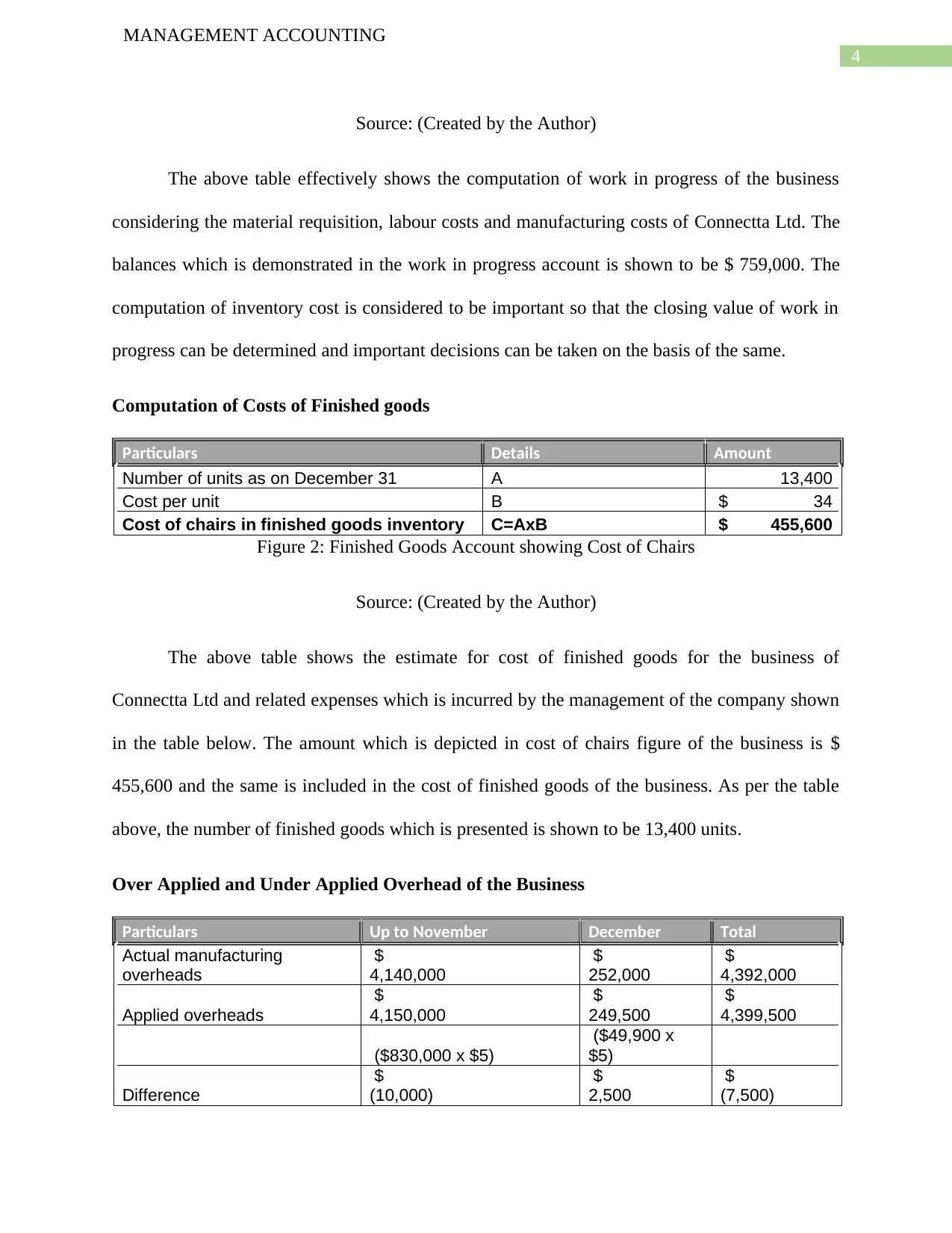
4
MANAGEMENT ACCOUNTING
Source: (Created by the Author)
The above table effectively shows the computation of work in progress of the business
considering the material requisition, labour costs and manufacturing costs of Connectta Ltd. The
balances which is demonstrated in the work in progress account is shown to be $ 759,000. The
computation of inventory cost is considered to be important so that the closing value of work in
progress can be determined and important decisions can be taken on the basis of the same.
Computation of Costs of Finished goods
Particulars Details Amount
Number of units as on December 31 A 13,400
Cost per unit B $ 34
Cost of chairs in finished goods inventory C=AxB $ 455,600
Figure 2: Finished Goods Account showing Cost of Chairs
Source: (Created by the Author)
The above table shows the estimate for cost of finished goods for the business of
Connectta Ltd and related expenses which is incurred by the management of the company shown
in the table below. The amount which is depicted in cost of chairs figure of the business is $
455,600 and the same is included in the cost of finished goods of the business. As per the table
above, the number of finished goods which is presented is shown to be 13,400 units.
Over Applied and Under Applied Overhead of the Business
Particulars Up to November December Total
Actual manufacturing
overheads
$
4,140,000
$
252,000
$
4,392,000
Applied overheads
$
4,150,000
$
249,500
$
4,399,500
($830,000 x $5)
($49,900 x
$5)
Difference
$
(10,000)
$
2,500
$
(7,500)
MANAGEMENT ACCOUNTING
Source: (Created by the Author)
The above table effectively shows the computation of work in progress of the business
considering the material requisition, labour costs and manufacturing costs of Connectta Ltd. The
balances which is demonstrated in the work in progress account is shown to be $ 759,000. The
computation of inventory cost is considered to be important so that the closing value of work in
progress can be determined and important decisions can be taken on the basis of the same.
Computation of Costs of Finished goods
Particulars Details Amount
Number of units as on December 31 A 13,400
Cost per unit B $ 34
Cost of chairs in finished goods inventory C=AxB $ 455,600
Figure 2: Finished Goods Account showing Cost of Chairs
Source: (Created by the Author)
The above table shows the estimate for cost of finished goods for the business of
Connectta Ltd and related expenses which is incurred by the management of the company shown
in the table below. The amount which is depicted in cost of chairs figure of the business is $
455,600 and the same is included in the cost of finished goods of the business. As per the table
above, the number of finished goods which is presented is shown to be 13,400 units.
Over Applied and Under Applied Overhead of the Business
Particulars Up to November December Total
Actual manufacturing
overheads
$
4,140,000
$
252,000
$
4,392,000
Applied overheads
$
4,150,000
$
249,500
$
4,399,500
($830,000 x $5)
($49,900 x
$5)
Difference
$
(10,000)
$
2,500
$
(7,500)
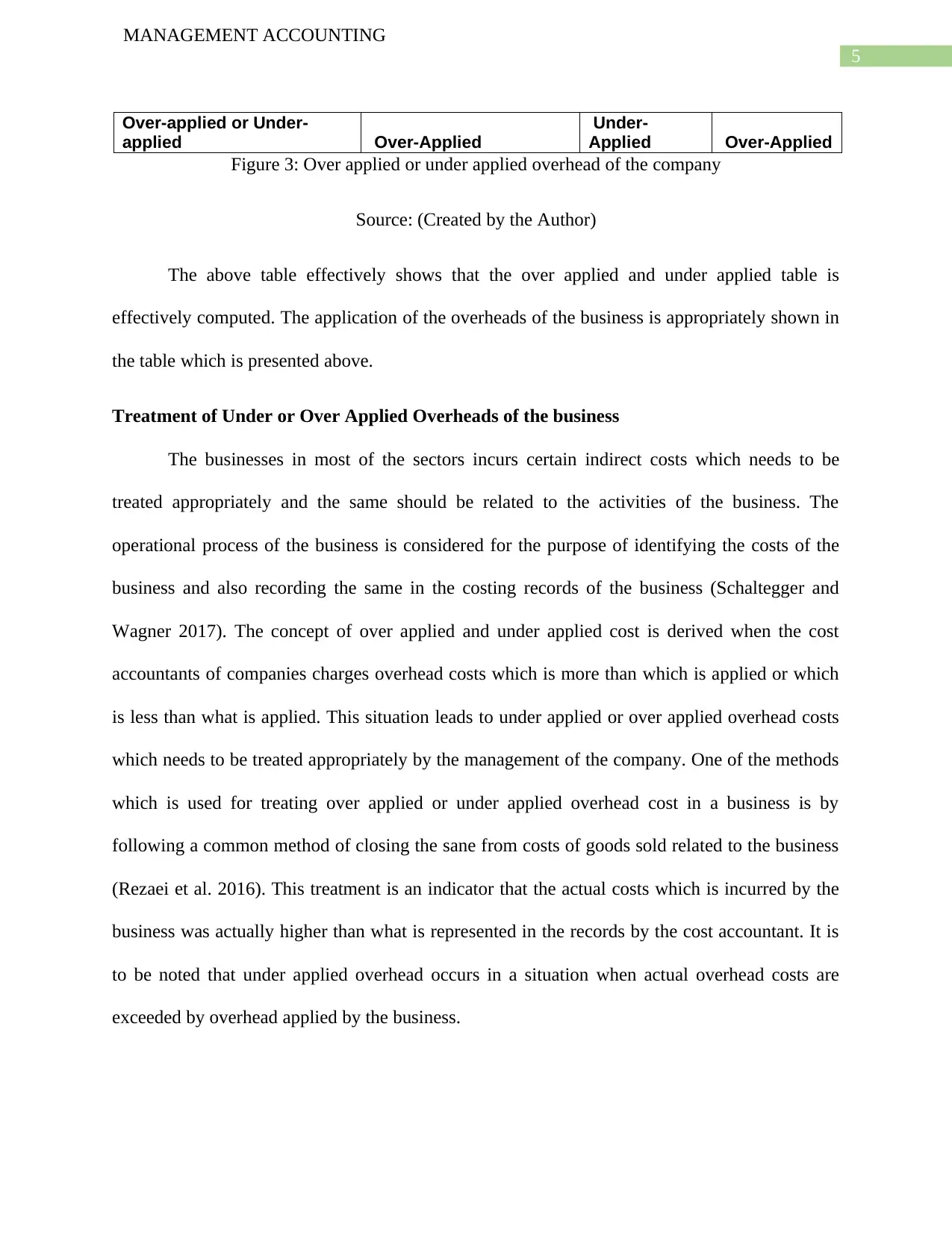
5
MANAGEMENT ACCOUNTING
Over-applied or Under-
applied Over-Applied
Under-
Applied Over-Applied
Figure 3: Over applied or under applied overhead of the company
Source: (Created by the Author)
The above table effectively shows that the over applied and under applied table is
effectively computed. The application of the overheads of the business is appropriately shown in
the table which is presented above.
Treatment of Under or Over Applied Overheads of the business
The businesses in most of the sectors incurs certain indirect costs which needs to be
treated appropriately and the same should be related to the activities of the business. The
operational process of the business is considered for the purpose of identifying the costs of the
business and also recording the same in the costing records of the business (Schaltegger and
Wagner 2017). The concept of over applied and under applied cost is derived when the cost
accountants of companies charges overhead costs which is more than which is applied or which
is less than what is applied. This situation leads to under applied or over applied overhead costs
which needs to be treated appropriately by the management of the company. One of the methods
which is used for treating over applied or under applied overhead cost in a business is by
following a common method of closing the sane from costs of goods sold related to the business
(Rezaei et al. 2016). This treatment is an indicator that the actual costs which is incurred by the
business was actually higher than what is represented in the records by the cost accountant. It is
to be noted that under applied overhead occurs in a situation when actual overhead costs are
exceeded by overhead applied by the business.
MANAGEMENT ACCOUNTING
Over-applied or Under-
applied Over-Applied
Under-
Applied Over-Applied
Figure 3: Over applied or under applied overhead of the company
Source: (Created by the Author)
The above table effectively shows that the over applied and under applied table is
effectively computed. The application of the overheads of the business is appropriately shown in
the table which is presented above.
Treatment of Under or Over Applied Overheads of the business
The businesses in most of the sectors incurs certain indirect costs which needs to be
treated appropriately and the same should be related to the activities of the business. The
operational process of the business is considered for the purpose of identifying the costs of the
business and also recording the same in the costing records of the business (Schaltegger and
Wagner 2017). The concept of over applied and under applied cost is derived when the cost
accountants of companies charges overhead costs which is more than which is applied or which
is less than what is applied. This situation leads to under applied or over applied overhead costs
which needs to be treated appropriately by the management of the company. One of the methods
which is used for treating over applied or under applied overhead cost in a business is by
following a common method of closing the sane from costs of goods sold related to the business
(Rezaei et al. 2016). This treatment is an indicator that the actual costs which is incurred by the
business was actually higher than what is represented in the records by the cost accountant. It is
to be noted that under applied overhead occurs in a situation when actual overhead costs are
exceeded by overhead applied by the business.
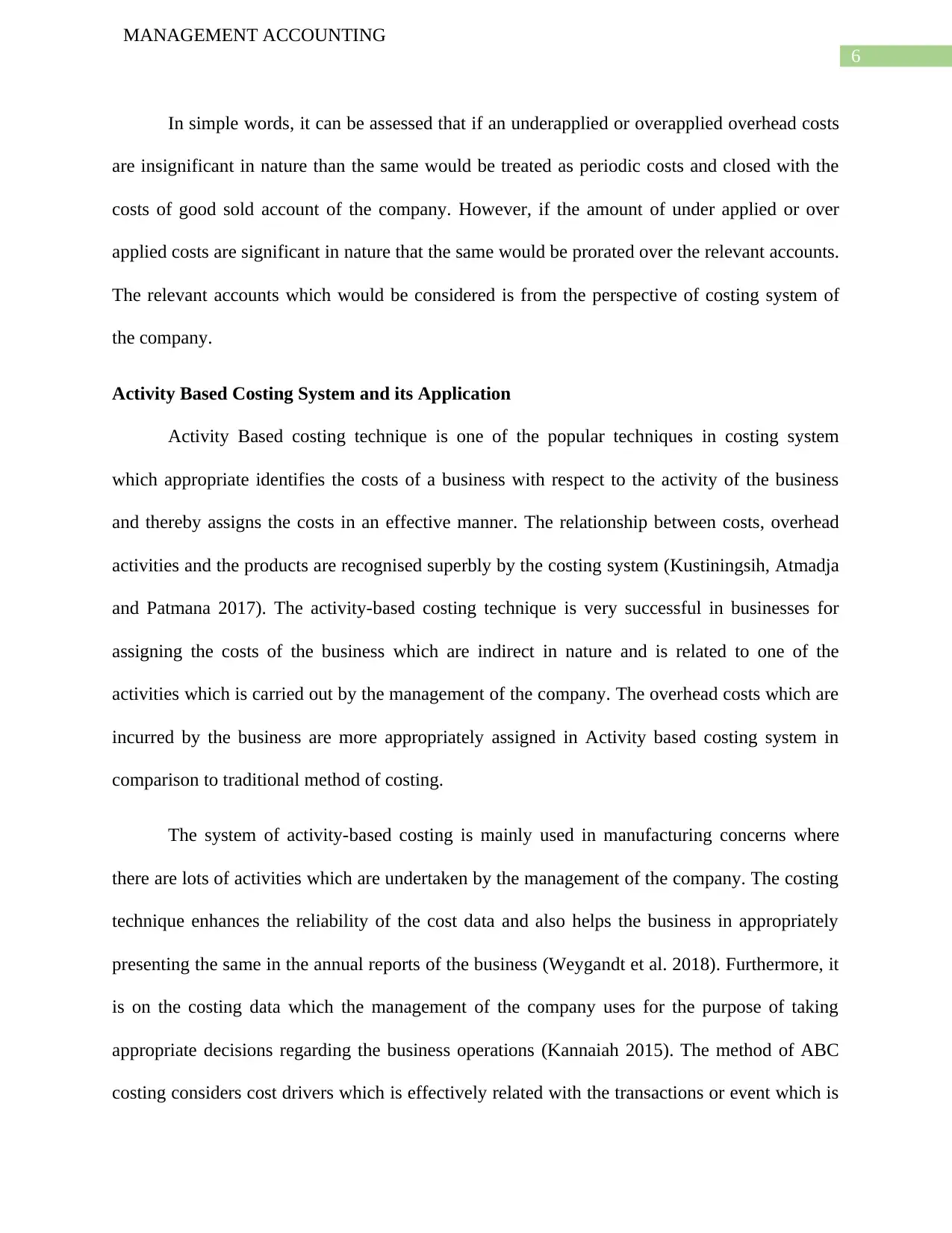
6
MANAGEMENT ACCOUNTING
In simple words, it can be assessed that if an underapplied or overapplied overhead costs
are insignificant in nature than the same would be treated as periodic costs and closed with the
costs of good sold account of the company. However, if the amount of under applied or over
applied costs are significant in nature that the same would be prorated over the relevant accounts.
The relevant accounts which would be considered is from the perspective of costing system of
the company.
Activity Based Costing System and its Application
Activity Based costing technique is one of the popular techniques in costing system
which appropriate identifies the costs of a business with respect to the activity of the business
and thereby assigns the costs in an effective manner. The relationship between costs, overhead
activities and the products are recognised superbly by the costing system (Kustiningsih, Atmadja
and Patmana 2017). The activity-based costing technique is very successful in businesses for
assigning the costs of the business which are indirect in nature and is related to one of the
activities which is carried out by the management of the company. The overhead costs which are
incurred by the business are more appropriately assigned in Activity based costing system in
comparison to traditional method of costing.
The system of activity-based costing is mainly used in manufacturing concerns where
there are lots of activities which are undertaken by the management of the company. The costing
technique enhances the reliability of the cost data and also helps the business in appropriately
presenting the same in the annual reports of the business (Weygandt et al. 2018). Furthermore, it
is on the costing data which the management of the company uses for the purpose of taking
appropriate decisions regarding the business operations (Kannaiah 2015). The method of ABC
costing considers cost drivers which is effectively related with the transactions or event which is
MANAGEMENT ACCOUNTING
In simple words, it can be assessed that if an underapplied or overapplied overhead costs
are insignificant in nature than the same would be treated as periodic costs and closed with the
costs of good sold account of the company. However, if the amount of under applied or over
applied costs are significant in nature that the same would be prorated over the relevant accounts.
The relevant accounts which would be considered is from the perspective of costing system of
the company.
Activity Based Costing System and its Application
Activity Based costing technique is one of the popular techniques in costing system
which appropriate identifies the costs of a business with respect to the activity of the business
and thereby assigns the costs in an effective manner. The relationship between costs, overhead
activities and the products are recognised superbly by the costing system (Kustiningsih, Atmadja
and Patmana 2017). The activity-based costing technique is very successful in businesses for
assigning the costs of the business which are indirect in nature and is related to one of the
activities which is carried out by the management of the company. The overhead costs which are
incurred by the business are more appropriately assigned in Activity based costing system in
comparison to traditional method of costing.
The system of activity-based costing is mainly used in manufacturing concerns where
there are lots of activities which are undertaken by the management of the company. The costing
technique enhances the reliability of the cost data and also helps the business in appropriately
presenting the same in the annual reports of the business (Weygandt et al. 2018). Furthermore, it
is on the costing data which the management of the company uses for the purpose of taking
appropriate decisions regarding the business operations (Kannaiah 2015). The method of ABC
costing considers cost drivers which is effectively related with the transactions or event which is
Paraphrase This Document
Need a fresh take? Get an instant paraphrase of this document with our AI Paraphraser
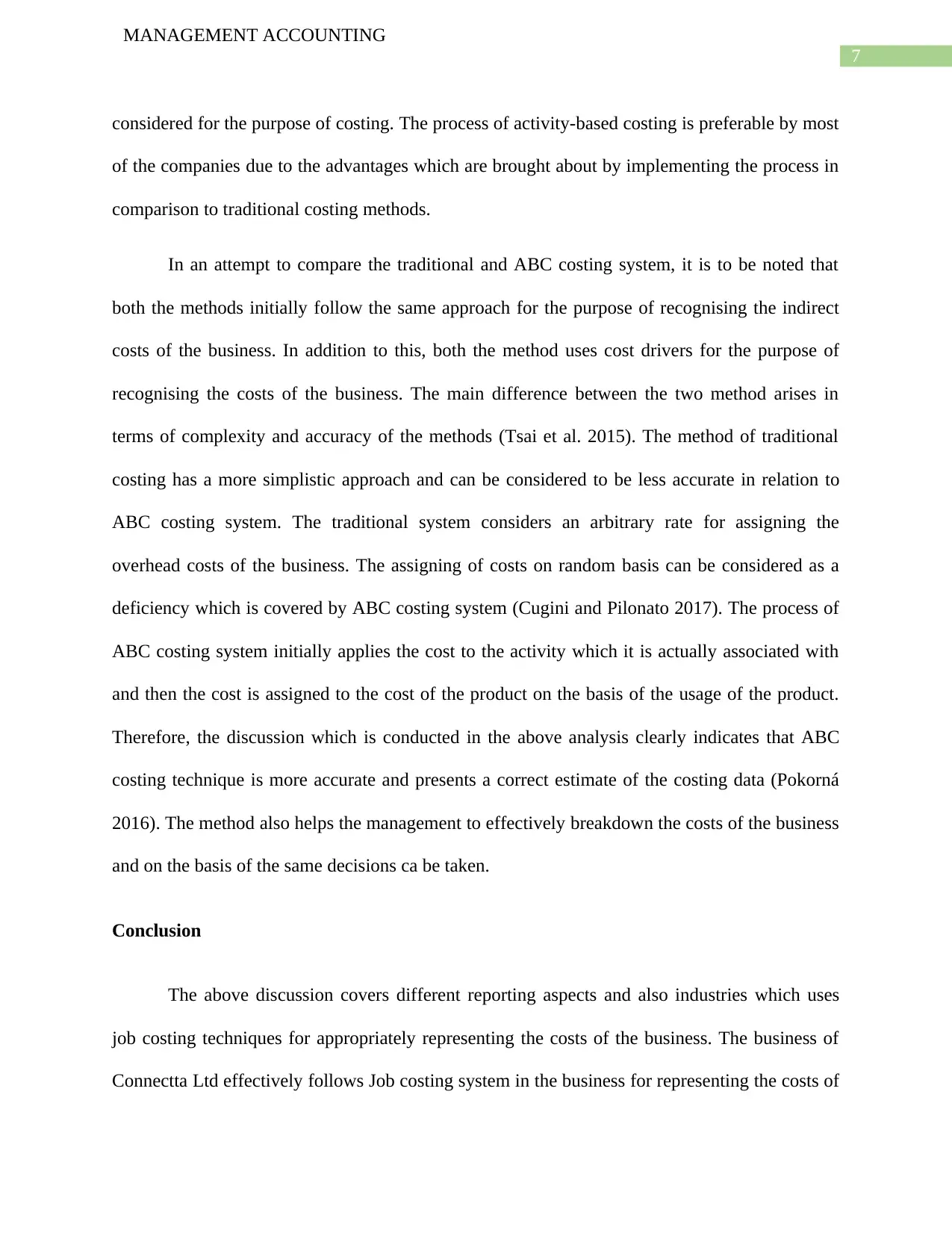
7
MANAGEMENT ACCOUNTING
considered for the purpose of costing. The process of activity-based costing is preferable by most
of the companies due to the advantages which are brought about by implementing the process in
comparison to traditional costing methods.
In an attempt to compare the traditional and ABC costing system, it is to be noted that
both the methods initially follow the same approach for the purpose of recognising the indirect
costs of the business. In addition to this, both the method uses cost drivers for the purpose of
recognising the costs of the business. The main difference between the two method arises in
terms of complexity and accuracy of the methods (Tsai et al. 2015). The method of traditional
costing has a more simplistic approach and can be considered to be less accurate in relation to
ABC costing system. The traditional system considers an arbitrary rate for assigning the
overhead costs of the business. The assigning of costs on random basis can be considered as a
deficiency which is covered by ABC costing system (Cugini and Pilonato 2017). The process of
ABC costing system initially applies the cost to the activity which it is actually associated with
and then the cost is assigned to the cost of the product on the basis of the usage of the product.
Therefore, the discussion which is conducted in the above analysis clearly indicates that ABC
costing technique is more accurate and presents a correct estimate of the costing data (Pokorná
2016). The method also helps the management to effectively breakdown the costs of the business
and on the basis of the same decisions ca be taken.
Conclusion
The above discussion covers different reporting aspects and also industries which uses
job costing techniques for appropriately representing the costs of the business. The business of
Connectta Ltd effectively follows Job costing system in the business for representing the costs of
MANAGEMENT ACCOUNTING
considered for the purpose of costing. The process of activity-based costing is preferable by most
of the companies due to the advantages which are brought about by implementing the process in
comparison to traditional costing methods.
In an attempt to compare the traditional and ABC costing system, it is to be noted that
both the methods initially follow the same approach for the purpose of recognising the indirect
costs of the business. In addition to this, both the method uses cost drivers for the purpose of
recognising the costs of the business. The main difference between the two method arises in
terms of complexity and accuracy of the methods (Tsai et al. 2015). The method of traditional
costing has a more simplistic approach and can be considered to be less accurate in relation to
ABC costing system. The traditional system considers an arbitrary rate for assigning the
overhead costs of the business. The assigning of costs on random basis can be considered as a
deficiency which is covered by ABC costing system (Cugini and Pilonato 2017). The process of
ABC costing system initially applies the cost to the activity which it is actually associated with
and then the cost is assigned to the cost of the product on the basis of the usage of the product.
Therefore, the discussion which is conducted in the above analysis clearly indicates that ABC
costing technique is more accurate and presents a correct estimate of the costing data (Pokorná
2016). The method also helps the management to effectively breakdown the costs of the business
and on the basis of the same decisions ca be taken.
Conclusion
The above discussion covers different reporting aspects and also industries which uses
job costing techniques for appropriately representing the costs of the business. The business of
Connectta Ltd effectively follows Job costing system in the business for representing the costs of
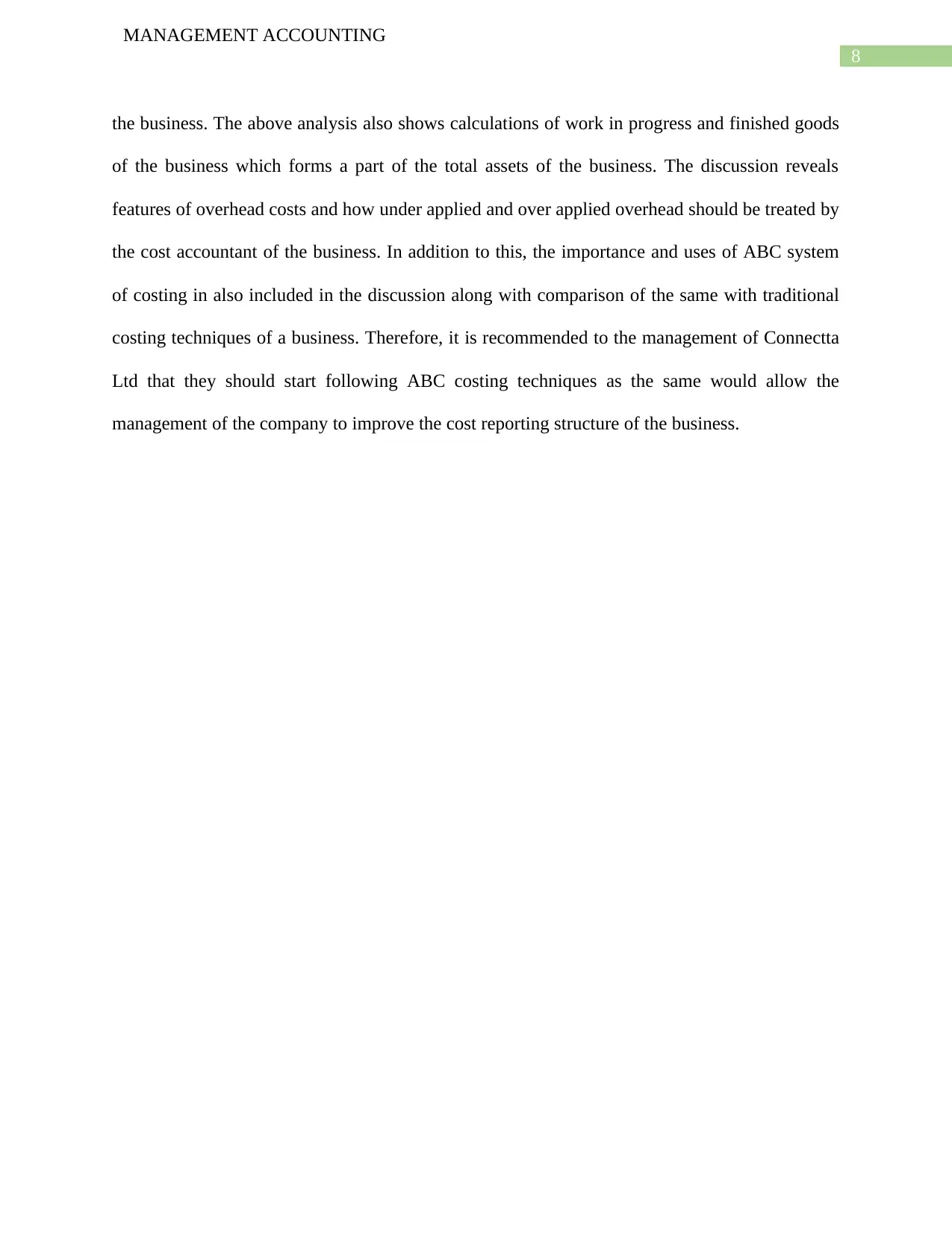
8
MANAGEMENT ACCOUNTING
the business. The above analysis also shows calculations of work in progress and finished goods
of the business which forms a part of the total assets of the business. The discussion reveals
features of overhead costs and how under applied and over applied overhead should be treated by
the cost accountant of the business. In addition to this, the importance and uses of ABC system
of costing in also included in the discussion along with comparison of the same with traditional
costing techniques of a business. Therefore, it is recommended to the management of Connectta
Ltd that they should start following ABC costing techniques as the same would allow the
management of the company to improve the cost reporting structure of the business.
MANAGEMENT ACCOUNTING
the business. The above analysis also shows calculations of work in progress and finished goods
of the business which forms a part of the total assets of the business. The discussion reveals
features of overhead costs and how under applied and over applied overhead should be treated by
the cost accountant of the business. In addition to this, the importance and uses of ABC system
of costing in also included in the discussion along with comparison of the same with traditional
costing techniques of a business. Therefore, it is recommended to the management of Connectta
Ltd that they should start following ABC costing techniques as the same would allow the
management of the company to improve the cost reporting structure of the business.
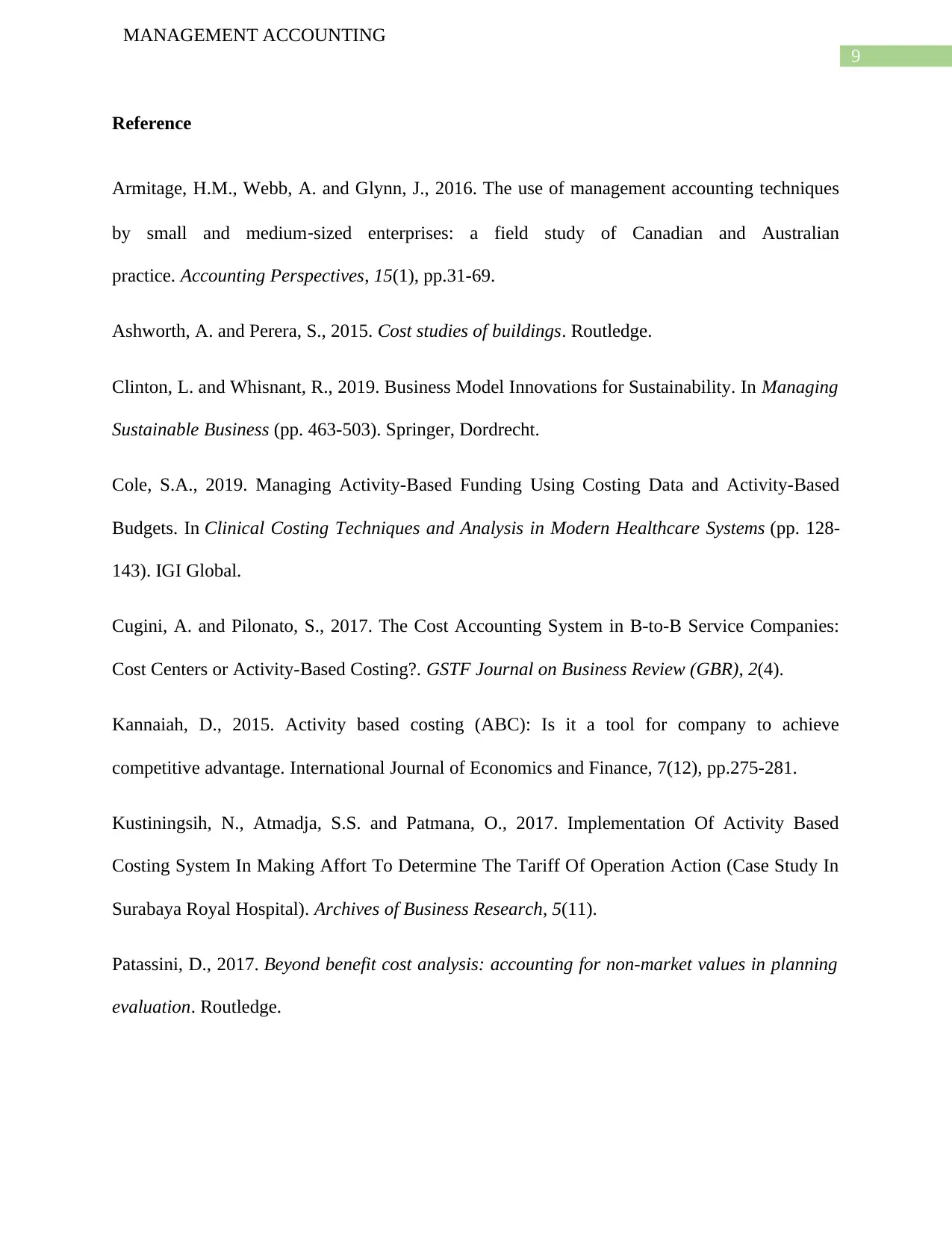
9
MANAGEMENT ACCOUNTING
Reference
Armitage, H.M., Webb, A. and Glynn, J., 2016. The use of management accounting techniques
by small and medium‐sized enterprises: a field study of Canadian and Australian
practice. Accounting Perspectives, 15(1), pp.31-69.
Ashworth, A. and Perera, S., 2015. Cost studies of buildings. Routledge.
Clinton, L. and Whisnant, R., 2019. Business Model Innovations for Sustainability. In Managing
Sustainable Business (pp. 463-503). Springer, Dordrecht.
Cole, S.A., 2019. Managing Activity-Based Funding Using Costing Data and Activity-Based
Budgets. In Clinical Costing Techniques and Analysis in Modern Healthcare Systems (pp. 128-
143). IGI Global.
Cugini, A. and Pilonato, S., 2017. The Cost Accounting System in B-to-B Service Companies:
Cost Centers or Activity-Based Costing?. GSTF Journal on Business Review (GBR), 2(4).
Kannaiah, D., 2015. Activity based costing (ABC): Is it a tool for company to achieve
competitive advantage. International Journal of Economics and Finance, 7(12), pp.275-281.
Kustiningsih, N., Atmadja, S.S. and Patmana, O., 2017. Implementation Of Activity Based
Costing System In Making Affort To Determine The Tariff Of Operation Action (Case Study In
Surabaya Royal Hospital). Archives of Business Research, 5(11).
Patassini, D., 2017. Beyond benefit cost analysis: accounting for non-market values in planning
evaluation. Routledge.
MANAGEMENT ACCOUNTING
Reference
Armitage, H.M., Webb, A. and Glynn, J., 2016. The use of management accounting techniques
by small and medium‐sized enterprises: a field study of Canadian and Australian
practice. Accounting Perspectives, 15(1), pp.31-69.
Ashworth, A. and Perera, S., 2015. Cost studies of buildings. Routledge.
Clinton, L. and Whisnant, R., 2019. Business Model Innovations for Sustainability. In Managing
Sustainable Business (pp. 463-503). Springer, Dordrecht.
Cole, S.A., 2019. Managing Activity-Based Funding Using Costing Data and Activity-Based
Budgets. In Clinical Costing Techniques and Analysis in Modern Healthcare Systems (pp. 128-
143). IGI Global.
Cugini, A. and Pilonato, S., 2017. The Cost Accounting System in B-to-B Service Companies:
Cost Centers or Activity-Based Costing?. GSTF Journal on Business Review (GBR), 2(4).
Kannaiah, D., 2015. Activity based costing (ABC): Is it a tool for company to achieve
competitive advantage. International Journal of Economics and Finance, 7(12), pp.275-281.
Kustiningsih, N., Atmadja, S.S. and Patmana, O., 2017. Implementation Of Activity Based
Costing System In Making Affort To Determine The Tariff Of Operation Action (Case Study In
Surabaya Royal Hospital). Archives of Business Research, 5(11).
Patassini, D., 2017. Beyond benefit cost analysis: accounting for non-market values in planning
evaluation. Routledge.
Secure Best Marks with AI Grader
Need help grading? Try our AI Grader for instant feedback on your assignments.
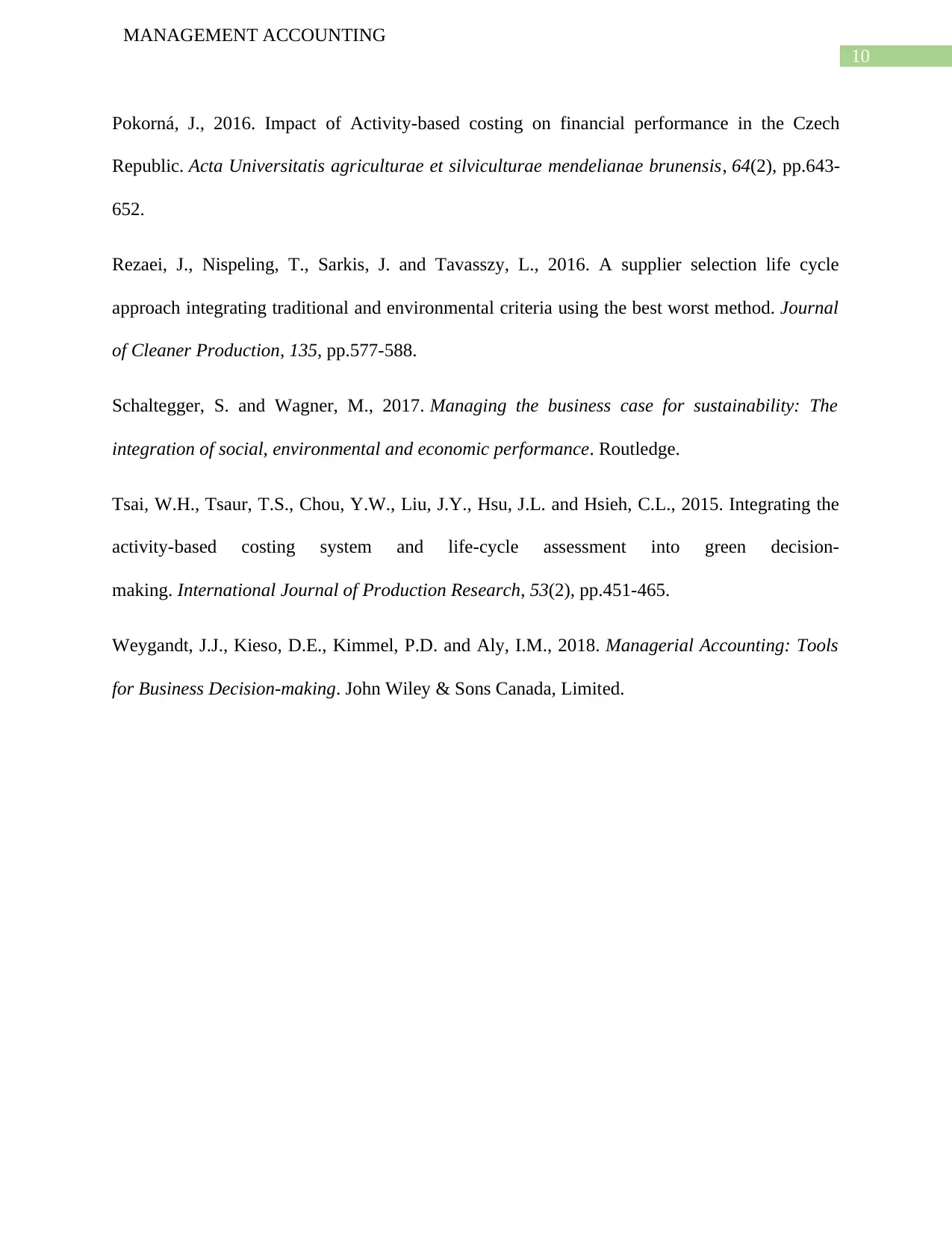
10
MANAGEMENT ACCOUNTING
Pokorná, J., 2016. Impact of Activity-based costing on financial performance in the Czech
Republic. Acta Universitatis agriculturae et silviculturae mendelianae brunensis, 64(2), pp.643-
652.
Rezaei, J., Nispeling, T., Sarkis, J. and Tavasszy, L., 2016. A supplier selection life cycle
approach integrating traditional and environmental criteria using the best worst method. Journal
of Cleaner Production, 135, pp.577-588.
Schaltegger, S. and Wagner, M., 2017. Managing the business case for sustainability: The
integration of social, environmental and economic performance. Routledge.
Tsai, W.H., Tsaur, T.S., Chou, Y.W., Liu, J.Y., Hsu, J.L. and Hsieh, C.L., 2015. Integrating the
activity-based costing system and life-cycle assessment into green decision-
making. International Journal of Production Research, 53(2), pp.451-465.
Weygandt, J.J., Kieso, D.E., Kimmel, P.D. and Aly, I.M., 2018. Managerial Accounting: Tools
for Business Decision-making. John Wiley & Sons Canada, Limited.
MANAGEMENT ACCOUNTING
Pokorná, J., 2016. Impact of Activity-based costing on financial performance in the Czech
Republic. Acta Universitatis agriculturae et silviculturae mendelianae brunensis, 64(2), pp.643-
652.
Rezaei, J., Nispeling, T., Sarkis, J. and Tavasszy, L., 2016. A supplier selection life cycle
approach integrating traditional and environmental criteria using the best worst method. Journal
of Cleaner Production, 135, pp.577-588.
Schaltegger, S. and Wagner, M., 2017. Managing the business case for sustainability: The
integration of social, environmental and economic performance. Routledge.
Tsai, W.H., Tsaur, T.S., Chou, Y.W., Liu, J.Y., Hsu, J.L. and Hsieh, C.L., 2015. Integrating the
activity-based costing system and life-cycle assessment into green decision-
making. International Journal of Production Research, 53(2), pp.451-465.
Weygandt, J.J., Kieso, D.E., Kimmel, P.D. and Aly, I.M., 2018. Managerial Accounting: Tools
for Business Decision-making. John Wiley & Sons Canada, Limited.
1 out of 11
Related Documents
Your All-in-One AI-Powered Toolkit for Academic Success.
+13062052269
info@desklib.com
Available 24*7 on WhatsApp / Email
![[object Object]](/_next/static/media/star-bottom.7253800d.svg)
Unlock your academic potential
© 2024 | Zucol Services PVT LTD | All rights reserved.





